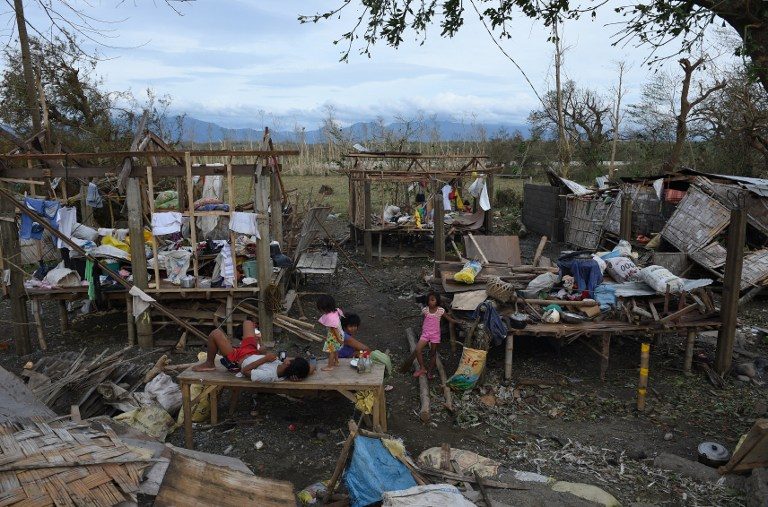SUMMARY
This is AI generated summarization, which may have errors. For context, always refer to the full article.

SAN PABLO, Philippines (UPDATED) – One of the most powerful typhoons to ever hit the Philippines killed at least 8 people on Thursday, October 20, as ferocious gales and landslides destroyed tens of thousands of homes.
Super Typhoon Haima (local name Lawin) struck late on Wednesday night with winds similar to those of catastrophic Haiyan in 2013, which was then the strongest storm to strike the disaster-prone Southeast Asian archipelago and claimed more than 7,350 lives. (READ: Typhoon Lawin leaves PH Area of Responsibility)
Haima then roared across mountain and farming communities of the northern regions of the main island of Luzon overnight, causing widespread destruction and killing at least 12 people, 8 from the Cordillera Administrative Region and 4 from Cagayan province as of October 21.
“We were frightened because of the strong winds. There was no power, no help coming,” Jovy Dalupan, 20, told AFP as she sheltered at nightfall on the side of a highway in San Pablo, a badly damaged town of 20,000 people in Isabela province.
Dalupan, her two young daughters and husband, were forced to flee to the highway along with their neighbours during the height of the storm when their shanty homes, made of plywood, were ripped apart.
“We were soaked when the roof flew off, even my little babies got drenched… all of our clothes were drenched. We have nothing to change into.”
Haima hit coastal towns facing the Pacific Ocean with sustained winds of 225 kilometers (140 miles) an hour, and wind gusts of up to 315 kilometers. (READ: Lawin ‘possibly damaged 100% of houses’ in Tuguegarao City)
It weakened overnight as it rammed into giant mountain ranges and by Thursday morning had passed over the western edge of Luzon and into the South China Sea, heading towards southern China.
The governor of Cagayan, a province of 600,000 people neighbouring Isabela where Haima made landfall, said the entire region was without power as he reported widespread destruction.
“Almost every house here has been damaged,” governor Manuel Mamba told ABS CBN television.
Prayers and preparations
President Rodrigo Duterte said on Wednesday night all possible preparations had been made for Haima, with tens of thousands of people evacuated, but he still struck an ominous tone. (IN PHOTOS: Floods, fallen trees in Ilocos Sur)
“We only pray we be spared the destruction such as the previous times, which brought agony and suffering,” Duterte said in Beijing, where he was on a state visit.
“But we are ready. Everything has been deployed.”
About 10 million people across the northern parts of Luzon were at risk, according to the government’s disaster risk management council.
Authorities said two of those killed, aged 16 and 17, were buried in a landslide while sleeping in a house in Ifugao, a mountainous area that is home to stunning rice terraces that are listed by the United Nations as a World Heritage site.
Two other people were buried in a shanty in another mountainous region, the disaster risk council’s division in the northern Philippines reported.
At least eight people had been confirmed dead, according to Edgar Allan Tabell, director of the national government’s disaster information coordinating centre in Manila.
But with authorities in many devastated areas still unable to report back because of power and communication lines being cut, the death toll was expected to rise.
The Philippine islands are often the first major landmass to be hit by storms that generate over the Pacific Ocean. The Southeast Asian archipelago endures about 20 major storms each year, many of them deadly.
The most powerful and deadliest was Haiyan, which destroyed entire towns in heavily populated areas of the central Philippines in November 2013.
The national capital Manila is about 350 kilometres south of where Haima struck land.
However the city, with about 12 million people, was not affected, hit only by moderate winds overnight and little rain.
Haima was the second typhoon to hit the northern Philippines in a week, after Sarika struck on Sunday claiming at least one life and leaving three people missing.
In Hong Kong, the city’s seven million residents were preparing for more heavy rain and disruptive weather as Typhoon Haima approached, following days of monsoon downpours.
Airlines in the regional travel hub warned of likely flight disruptions on Friday and Saturday. – Rappler.com
Add a comment
How does this make you feel?
There are no comments yet. Add your comment to start the conversation.